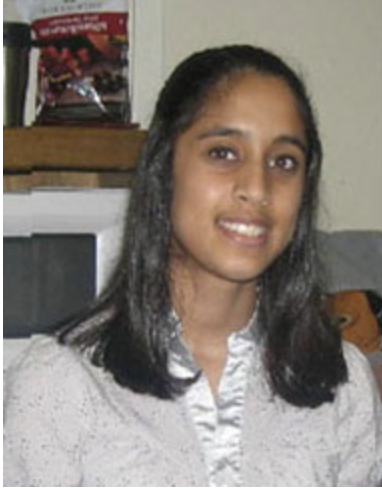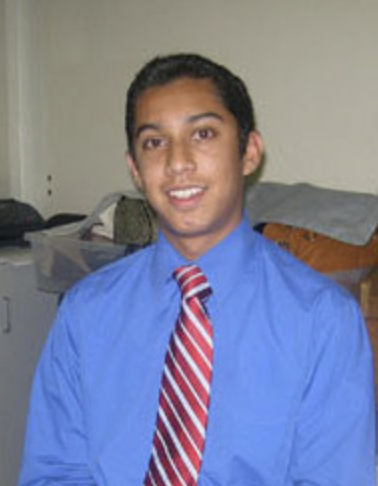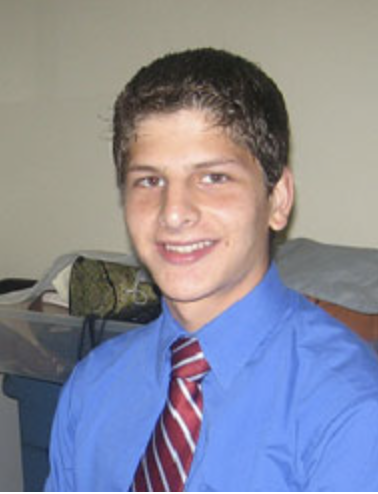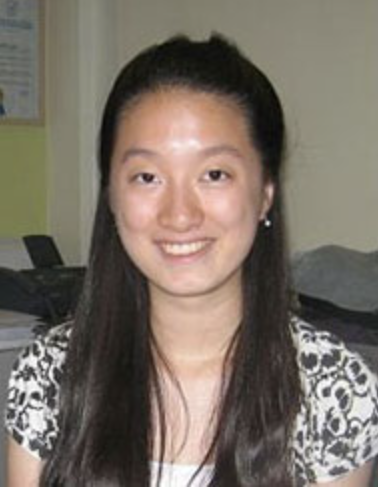2010
Savitha Racha, Commack High School
In today’s world, it’s becoming more and more common to come across newspaper headlines alluding to new discoveries in the rapidly progressing field of breast cancer research. Never did I imagine that I would one day be working side-by-side with the very scientists who are responsible for these discoveries. Organized by the Huntington Breast Cancer Action Coalition, the Students and Scientists Environmental Research Program provided me with the precious opportunity to conduct research in the Soto & Sonnenschein Laboratory at Tufts University Medical Center this past summer. Participating in the program not only expanded my understanding of oncological medicine; it gave me a new appreciation for environmental research.
In the current industrial race to develop more efficient products, manufacturers driven by commercial revenue tend to overlook consumer health and safety. In doing so, people are inadvertently being exposed to environmental carcinogens, some of which act as endocrine disruptors that upset body functions. The Soto & Sonnenschein laboratory studies the morphological effects of xenoestrogen bisphenol A - a chemical that is commonly found in plastics and metal cans - on the mammary glands. I contributed to this effort by examining tissues under a microscope, preparing whole mounts, and performing hematoxylin and eosin stains and immunocytochemistries.
Due to the availability of the necessary resources and facilities, this program provided the perfect opportunity to obtain laboratory research exposure. I gained comprehensive knowledge about mammary biology, the operation of laboratory instruments, and lab interaction. Getting an “insider’s look” at cutting-edge breast cancer research through the Students and Scientists Environmental Research Program was a fascinating and valuable opportunity that I am thankful to have experienced. I hope to share my insights from this experience with the community, as education is the first step to addressing the increasingly prevalent world issue of breast cancer.
Chirag Munim, Northport H.S.
This summer I was granted a wonderful opportunity by the Huntington Breast Cancer Action Coalition as an intern at Silent Spring Institute. The HBCAC Students and Scientists internship program allowed me to gain priceless experience and exposure at a renowned research facility. One of the many avenues of breast cancer research that the Silent Spring organization is exploring includes breast cancer risk factors present in the environment. The institute mainly conducts epidemiological research. These epidemiological studies involve looking at factors affecting the health of a certain population which serves as the groundwork for interventions made in the interest of public health and preventive medicine. An example of a study that the organization has undertaken has been the testing of the Cape Cod water supply for certain endocrine disruptors, carcinogens, volatile organic chemical (VOCs), etc.
At the onset of my internship I was taught about many of the risk factors of breast cancer, the biology of the condition, as well as many of the current studies that are ongoing at the institute. With the guidance and advice from my mentor, Janet Ackerman, and the friendly and knowledgeable staff, I was able to conduct research and analyze significant information available to the everyday consumer regarding the unfortunate condition. My peers and I were given a project to work on throughout the course of our internship that would end up being beneficial for us and Silent Spring.
The project we undertook analyzed breast cancer risk in many consumer products through various methods and resources. First we looked at many creditable websites such as mayoclinic.com, komen.org, bcaction.org, etc. and analyzed the different assertions made by these organizations regarding certain controversial topics related to breast cancer risk. Different sites had different conclusions depending on the specific study they choose to reference. We wanted to see if the consumer would be able to obtain sufficient and accurate information about breast cancer risks present in specific products. Throughout our research we saw that many of these popular resources would disagree on many things, such as the extent of disruptions caused by parabens. Parabens are chemical preservatives that mimic naturally occurring estrogen and are believed to be linked to breast cancer. We realized that there was a great amount of speculation and uncertainty when linking breast cancer to the environment, so we approached the issue from a consumer standpoint.
We knew that due to the lack of FDA regulation regarding products such as deodorants, cosmetics, etc. on the market, there is a clear danger for many consumers. The second part of our project pushed us to explore two product-rating websites: cosmeticsdatabase.com run by Environmental Working Group (EWG) and goodguide.com. We were given a certain group of products ranging from skincare to kitty litter that were in current use for a Silent Spring Study and asked to search these products on the two rating systems. EWG rated the products on a scale of 0-10 based on how hazardous the product was. The Good Guide rating system included the product’s health rating and manufacturer’s environmental and social ratings (equal weight given to the 3 categories). We found it interesting that various parabens didn’t impact ratings because they were considered too controversial and some ingredients were unjustly portrayed less hazardous than others merely due to lack of evidence. The data we obtained revealed a moderate correlation between scores given by the two systems with some consensus between the two groups. We also noticed that by percentile, Environmental Working Group’s Skin Deep was more likely to rate products between 0-4, or more dangerous while Good Guide was more likely to rate items 4-8, or safer.
This internship was truly an amazing experience and an everlasting memory for me. I not only learned about breast cancer, but I was able to understand how non-profit organizations function and gained insight into the atmosphere of a work-environment setting. Some of the highlights of my internship outside of conducting the project included my attending research meetings concerning the staff which was extremely informative as they shed light on the work Silent Spring Institute undertakes. I believe that these meetings taught me so much about how a research team works together and how tasks are broken down. I also learned how connections to the media are significant because in the end, communicating results to the general public and spurring change in society is a vital goal for most organizations of this nature.
After communicating the results of our project to the staff of the institute in the form of a PowerPoint presentation, we received great feedback and beneficial advice. This advice came from many world renowned professionals in their fields of research, such as executive director Dr. Julia Brody and research scientist Dr. Robin Dodson. Having worked alongside these people of great expertise and communicating results amongst them, I feel that I must continue to connect with the public and instill in them the knowledge I’ve been fortunate enough to gain regarding breast cancer risk and preventive medicine. We all hope that our research may cause an increase in consumer awareness and their understanding of breast cancer risk factors.
Pablo Palacios, Walt Whitman H.S.
This summer I was given the privilege by the Huntington Breast Cancer Action Coalition to be selected for an internship at Silent Spring Institute, along with two other students. The institution’s name derives as an honor for a book written by Rachel Carson that introduced a different perspective of the environment and the health risks it may contain. Thus, Silent Spring is a non-profit organization that attempts to discover possible links between factors within the environment and the health effects that it may propose in perspective with breast cancer. Epidemiological studies are done annually throughout Massachusetts in order to test water samples to air particles in order to discover possible carcinogens, volatile organic chemicals, endocrine disruptors, and other plausible harmful components that may be a health risk. The research conducted not only identifies potential links, but also attempts to identify safer alternatives for consumers.
Throughout the course of my internship our mentor, Janet Ackerman, introduced a project to us in which we researched the information portrayed to average consumers about daily products. Furthermore, each of us was assigned various sites that we were to analyze the information being displayed and whether there was sufficient evidence to support their statements. While working on our project, we came across numerous products, such as cosmetics to deodorants, that various websites stated different conclusions of their potential health risks. In addition, we utilized two different online health rating systems, Good Guide and Skin Deep, which would be used to collect data for over two hundred different products provided by scientist Robin Dodson; these products ranged from cleaners to skin care. Along with the data collected we analyzed any possible correlation between the ratings and found a moderate correlation, indicating that sites provided similar ratings for some products while different for others.
Along with the issued project, Dr. Laurel Schaider allowed us to do a nitrate water sample test on three various water samples from the Charles River. At the end of the two week period, all three of us interns had a PowerPoint presentation in front of the staff lead by Executive Director Dr. Julia Brody. The presentation was followed by vigorous questions as well as suggestions on how to enhance our presentation and the information we portray. Working alongside professionals allowed me to obtain a glimpse of the work life while gathering as much useful information.
This amazing internship experience would not have come into fruition if it was not for the grant provided by Huntington Breast Cancer Action Coalition. The knowledge I have been taught throughout will be redirected to the community through presentations and outreaches in order to increase the awareness of breast cancer. The experience allowed me to develop an understanding of the field of breast cancer research through a different perspective of prevention rather than treatment.
Kimberly Shen, Walt Whitman High School
Beep! Beep! Beep! The incessant buzz of the alarm clock finally rouses the woman, who drowsily switches the OFF button. After a quick shower to start her day, she wraps her hair with a towel and gets dressed. When she finishes applying lotion to her face, she removes the towel and adds a bit of mousse to her moist hair. Finally, just before heading out the bathroom, she carefully applies her blush and mascara.
What is wrong with this picture? After all, this woman did nothing more than what millions of women across the nation do every morning. However, neither she nor many other Americans realize that the aforementioned cosmetics are contaminated with chemicals associated with breast cancer. Because a number of these products are items that many regularly use, I made the most of Silent Spring’s resources to expand my knowledge on this topic’s surprising controversies. By understanding the many potential dangers of cosmetics, I hope to spread awareness in the wider community, continue my research in this divisive subject, and above all, make healthier everyday choices.
During my two-week experience, I learned a great deal about the hidden toxins in some of the most mundane products. For example, many shampoos have been discovered to contain parabens, chemical preservatives that mimic naturally occurring estrogen and are linked to breast cancer. Meanwhile, phthalates, toxins commonly found in nail polish, are known to cause a range of reproductive problems and birth defects in lab animals. Such a widespread problem is additionally compounded by both the government’s failure to prohibit such chemicals and the cosmetics companies’ abilities to exploit the lax health regulations. A number of industries often vaguely label suspicious chemicals as “fragrance” or neglect to disclose them at all.
Under the guidance of Dr. Brody—the director of the Silent Spring Institute and Janet Ackerman—my mentor, I explored the Internet’s websites concerning this subject to understand the multifarious resources advocating community awareness. Unfortunately, the Internet itself is as contradicting as it is informative. One aspect of the project involved comparing the toxicity rating systems of two websites, Skin Deep and Good Guide, both of which analyzed the hazard levels of different cosmetics and worked to help Americans pick healthier alternatives. After converting the Skin Deep scale to match that of Good Guide, we interns discovered only a moderate correlation between the ratings. Such findings demonstrate that even experts disagree about what constitutes “safe” or “toxic.”
Given all these obstacles, one may wonder, is a future of safer cosmetics even realistic? The answer is yes. Already, many countries around the world, lead by those of the European Union, have taken steps to remedy this problem. With the European Union’s banning over 1100 chemicals, there is little doubt that the United States can do the same. What’s more, this cause is not only for the lawmakers, but also for consumers to stay involved. Whether consumers are calling their favorite cosmetics companies to request safer products or simply being more wary of label claims, every contribution truly makes a difference. Thus, by giving the cosmetics companies the makeovers that they desperately need, we can prevent countless Americans from undergoing the years of grief and suffering associated with breast cancer.
“Attitude is a little thing that makes a big difference.” ~Winston Churchill




